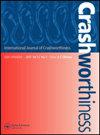飞机耐撞性:油箱内燃油的建模
IF 2
4区 工程技术
Q3 ENGINEERING, MANUFACTURING
引用次数: 0
摘要
摘要借助现代计算系统和商用有限元程序,可以对昂贵且不可重复的复杂机身截面耐撞性试验进行精确模拟。然而,与虚拟跌落测试相关的一些关键问题尚未得到解决。其中一个例子是对带有机载辅助油箱的机身部分进行垂直冲击试验,油箱内含有大量燃料,在耐撞性过程中不可避免地会发生流固耦合(FSI)。尽管如此,到目前为止,研究人员已经采用了质量分布技术,其中排除了燃料模型以避免FSI,并且燃料的总质量分布在燃料箱表面。因此,在本研究中,采用有限元代码Ansys Explicit来评估FSI相对于质量分布技术的重要性。基于塑性能量耗散、塑性变形和座椅轨道加速度响应的机身部分碰撞结果研究表明,在质量分布技术的情况下,油箱体表现为刚性,这最终限制了油箱吸收的塑性能量比FSI少得多。这也导致肋的破坏机制不同,主要是质量分布技术的破坏,而塑性铰破坏发生在FSI。最后,经过详细的比较和讨论,得出FSI法更适合表示副油箱内燃油的结论。关键词:燃料建模fsi方法飞机耐撞垂直跌落试验确认本研究未获得任何外部资助。作者感谢中国国家留学基金委(CSC)对博士教育的资助。此外,作者也感谢匿名审稿人,他的批评意见有助于提高手稿的整体质量。披露声明作者未报告潜在的利益冲突。本文章由计算机程序翻译,如有差异,请以英文原文为准。
Aircraft crashworthiness: modelling of fuel inside a conformable tank
AbstractWith the aid of modern computing systems and commercial finite element (FE) codes, the expensive and non-repeatable experimental crashworthiness testing of complex fuselage sections can be simulated accurately. However, some key problems associated with the virtual drop tests have yet to be resolved. One such example is the vertical impact test of the fuselage section with an onboard auxiliary fuel tank, which contains a large amount of fuel inside the fuel tank, where an inevitable fluid-structure interaction (FSI) takes place during crashworthiness. Despite this fact, to date, the researchers have adopted mass distribution techniques where fuel modelling is excluded to avoid the FSI and the total mass of the fuel is distributed over the fuel tank surfaces. Therefore, in this present study, an effort is made to evaluate the importance of FSI over mass distribution techniques to model the fuel adopting the FE code Ansys Explicit. Investigated crash outcomes of the fuselage section based on plastic energy dissipation, plastic deformation, and seat track acceleration responses suggest that in the case of mass distribution techniques, the tank body behaves as rigid, which eventually limits the fuel tank from absorbing much less plastic energy compared to FSI. This also leads to a different failure mechanism for the ribs, which are mainly crashing for mass distribution techniques, while plastic hinge failure occurs for FSI. Finally, after a detailed comparison and discussion, it is concluded that the FSI method is more suitable to represent fuel inside an auxiliary fuel tank.Keywords: Fuel modellingFSI methodaircraft crashworthinessvertical drop test AcknowledgmentThis research did not receive any external funding. The authors are grateful to the Chinese Scholarship Council (CSC) for funding Ph.D. education. In addition, the authors are also grateful to the anonymous reviewer whose critical observations helped to improve the overall quality of the manuscript.Disclosure statementNo potential conflict of interest was reported by the authors.
求助全文
通过发布文献求助,成功后即可免费获取论文全文。
去求助
来源期刊

International Journal of Crashworthiness
工程技术-工程:机械
CiteScore
3.70
自引率
10.50%
发文量
72
审稿时长
2.3 months
期刊介绍:
International Journal of Crashworthiness is the only journal covering all matters relating to the crashworthiness of road vehicles (including cars, trucks, buses and motorcycles), rail vehicles, air and spacecraft, ships and submarines, and on- and off-shore installations.
The Journal provides a unique forum for the publication of original research and applied studies relevant to an audience of academics, designers and practicing engineers. International Journal of Crashworthiness publishes both original research papers (full papers and short communications) and state-of-the-art reviews.
International Journal of Crashworthiness welcomes papers that address the quality of response of materials, body structures and energy-absorbing systems that are subjected to sudden dynamic loading, papers focused on new crashworthy structures, new concepts in restraint systems and realistic accident reconstruction.
 求助内容:
求助内容: 应助结果提醒方式:
应助结果提醒方式:


